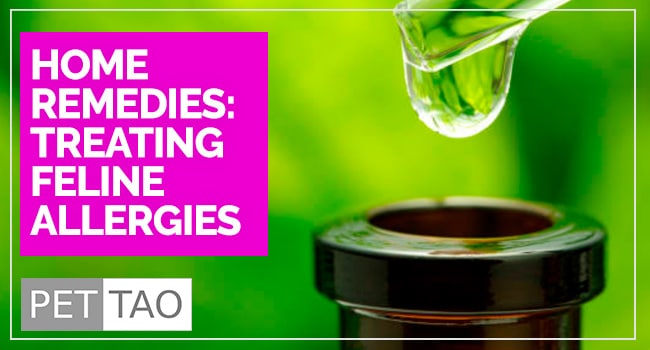Take an aspirin, and your headache goes away in about an hour.
Am I telling you to give your cat aspirin? NO!
But sometimes, a simple home remedy can relieve your cat’s allergy just like an aspirin alleviates a headache.
Home remedies are beneficial to cats suffering from allergies.
Use the following remedies as a stand-alone treatment or alongside pharmaceutical drugs to soothe cat allergy and itchy skin.
Simple Home Remedies for Cat Allergy Challenges
Apple Cider Vinegar
Add a small amount of Apple Cider Vinegar to your cat’s food.
Make sure to use apple cider vinegar, not distilled white vinegar.
Apple cider vinegar contains more nutrients than white vinegar.
Internal Use of Apple Cider Vinegar
Begin by adding 1⁄4 teaspoon to food twice daily for cats under 12 pounds, or 1⁄2 tsp for cats over 12 lbs.
Gradually increase the amount of vinegar used up to 1/4 teaspoon per 4 pounds of body weight if your cat finds vinegar palatable.
Adding apple cider vinegar to food can enhance your cat’s stomach acid content, making nutrient digestion more efficient.
Efficient digestion often eliminates some food intolerances.
Apple cider vinegar can also help maintain your cat’s acid/alkaline balance, improve digestion, act as a urinary system tonic, clear urinary tract infections.
Healthy changes boost your cat’s immune system and keep cat allergies at bay.
Topical Use of Apple Cider Vinegar
You can also use vinegar topically to treat pustules, hot spots, and other allergic reactions on the skin.
Just mix vinegar and water at a ratio of 1⁄2 water to 1⁄2 vinegar, and either spray or dab the mixture onto the problem areas.
If using topically on light-colored cats, you will want to use distilled white vinegar. Apple cider vinegar may darken the fur of white and very light-colored cats.
Pine Bark Extract
Administer pine bark extract internally as a supplement.
Pine bark extract has excellent antioxidant properties, supports the systems in control of inflammation, and inhibits the release of histamine from mast cells.
Mast cells release histamine, which triggers allergic symptoms such as coughing, sneezing, watery eyes, and scratchy throat when an allergen is present.
Pine bark extract blocks histamine release and decreases allergic symptoms.
Pine bark extract also helps normalize the immune response by inhibiting Nuclear Factor-Kappa B and lowers the sensitivity level for triggering an immune response.
To give your cat a pine bark extract supplement, read the human dosing recommendations on the label and give 1⁄8 to 1⁄4 the recommended amount to your cat.
Coconut Oil
Use coconut oil both internally and externally to help treat cat allergies.
Internal Use of Coconut Oil
Taken internally, coconut oil can help with skin conditions and allergies because of its antioxidant effect.
Coconut oil also helps a cat’s digestive system more easily absorb commercial cat food. Just add a small spoonful at each feeding.
Topical Use of Coconut Oil
Externally, coconut oil treats ear mites, mange, and the symptoms of dry, itchy skin.
Some cat owners even tout coconut oil as a flea treatment.
The antioxidant properties of coconut oil soothe allergic sores and broken skin.
Coconut oil’s antibacterial and antifungal properties also help keep bacterial and fungal infections from occurring.
And it’s totally ok for your cat to lick the coconut oil off his fur or skin.
He’s just given himself a nice, healthy internal dose of coconut oil supplement!
Do You Recognize a Hypoallergenic Cat Food When You See One?
Both dogs and cats thrive, or at least appear to thrive, on a certain diet.
Our pets thrive, not because of what we feed them, but in spite of what we feed them.
Food to Help Cat Allergies
Unapologetically, I feel the best food for cats with allergies – the most hypoallergenic cat food I have found – are the cat food recipes I created.
I have used my many years of training and experience to produce a cat food free of allergens that cause most cat allergies.
But, the information is not a sales pitch for PET | TAO. This article is merely my opinion based on my experiences.
Here in the West, we think immediately of medicine as the cure to the illness.
We almost always say, “my cat is sick” or “my cat has allergies – what can I give her?” The important thing to remember is:
Sickness is almost always a sign of a weakened, subdued, or highly reactive immune system.
Allergies indicate a highly reactive immune system – almost too strong.
Under either circumstance, over-medication might just be the wrong approach.
It could even be a fatal one.
Try food first!
You can successfully manage your cat’s allergies at home.
More Powerful Tools for Overcoming Cat Allergies
There are many quick and easy changes you can make at home to help you give your cat an edge on easing allergy challenges.
- Learn more about cat allergies.
- Switch to a Limited Ingredient Cat Food Recipe. PET | TAO Limited Ingredient Cat Food Recipe is naturally low in foods that stimulate an allergic response.
- Supplement with medicinal mushrooms. PET | TAO Complement Immune Supplement is a medicinal mushroom blend for easing inflammatory response and ease allergy symptoms.
- Try digestive enzymes and probiotics. PET | TAO Harmonize GI boosts gut health and combats food allergens.
- Feed Freeze Dried Lung Treats. According to TCVM, Lung is on the same meridian as the skin. Therefore, lung treats help both breathing and skin allergies. Lung treats support lung and skin similar to a glandular supplement in a “like treats like” fashion.
- Learn more about TCVM Herbal Remedies. Chinese medicine offers many amazing natural solutions for cat allergies Some good examples are:
Get A Phone Consultation with One of Our TCVM Veterinarians








